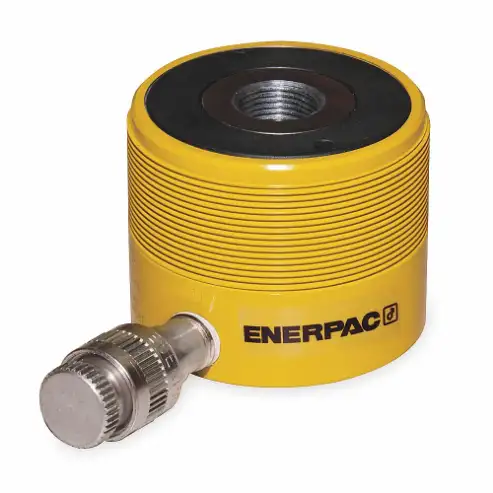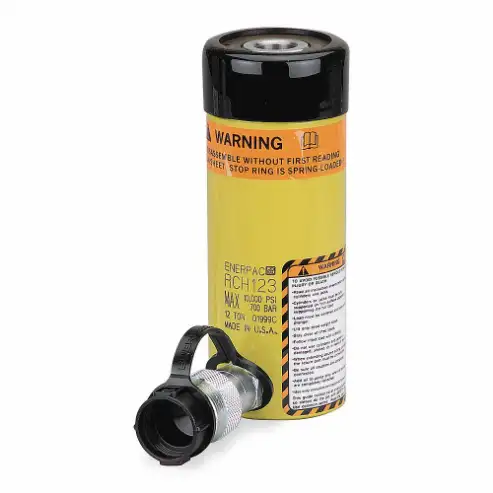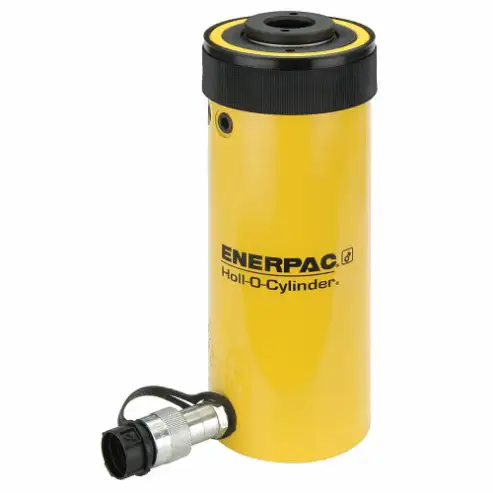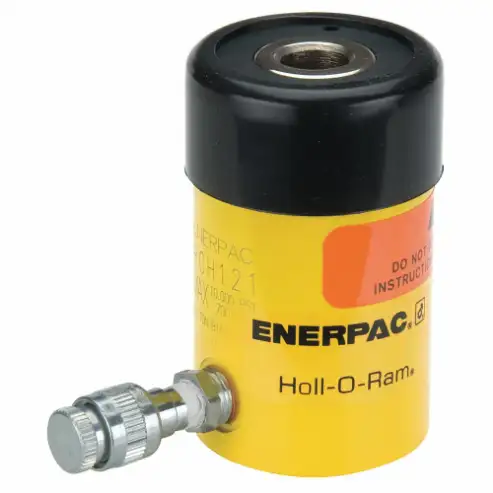Enerpac RCH-603 single-acting hydraulic cylinder is used to lift heavy loads and provide push forces while being powered by a hydraulic pump. This single-acting hollow plunger hydraulic cylinder features a spring return system with unidirectional stroke / force for lowering / pulling the extended plungers in offshore, marine, engineering, aerospace, agricultural, oil & gas, mining and food & production applications.
Features:
- Enerpac RCH-603 hollow plunger cylinder has a plunger that can move bi-directionally to handle both pull & push forces.
- This hydraulic cylinder can lift a maximum load of 63.6 tons to a maximum stroke length of 3 inches.
- This cylinder features a single-acting spring return for greater retraction speeds during lowering loads & pulling force applications.
- It is equipped with collar threads for easy attachment or load fixturing.
- This cylinder comes attached with a quick-connect CR-400 female coupler for easy connection to hydraulic hoses.
- Its body can handle a maximum hydraulic pressure of 10000 psi.
Compatible Accessories:
- Enerpac CR400 Hydraulic Coupler: These high flow couplers attach to the hydraulic cylinders for connecting to hydraulic lines.
- Enerpac HP5016 Hollow Saddle: These threaded hollow saddles are used to replace the damaged saddle in this Enerpac RCH-603 cylinder.
- Hoses: Enerpac offers high-quality hydraulic hoses for delivering hydraulic fluids while maintaining the integrity of the system.
Frequently Asked Questions:
Q. What are the differences between single-acting and double-acting hydraulic cylinders?
A. A single-acting hydraulic cylinder applies force through only one side of the piston. The piston generally extends by hydraulic pressure from the pump and then retracts using the load or inbuilt spring. A double-acting hydraulic cylinder on the other hand contains two ports to apply force in two directions for both expanding and retracting the piston.
Q. What does capacity & stroke length mean in this Enerpac RCH-603 hydraulic cylinder?
A. The capacity of the cylinder determines the amount of force exerted by the system and the stroke of the cylinder determines the maximum force exertion distance by the plunger on the load.
Q. How to bleed air from Enerpac hydraulic cylinders?
A.
- Attach the cylinder & pump with appropriate hose assembly while ensuring secure connections.
- Place the pump at a higher level than the cylinder if possible.
- Vent the pump reservoir and advance & retract the cylinder with little or no pressure.
- If the plunger operates smoothly, the air has bled out of the system. If the cylinder retracts in a jerky, spongy or pulsating manner, then continue cycling the pump & cylinder stem till the operation has become smooth.
Q. What is this Enerpac RCH-603 hydraulic cylinder made of?
A. Its steel body has baked enamel finish and a nickel-plated, floating centre tube for corrosion resistance, durability and increased product life.
 Change Country
Change Country






